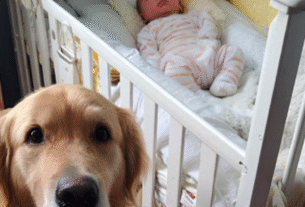At the corner of an old neighborhood stood a rundown shop. Outside it, every day, sat a thin black dog. People called him Blackie. He had no name, no collar, no known owner. Yet, he had become a familiar figure in the area.
Blackie was strange.
He didn’t bark.
He didn’t chase.
He didn’t beg.
He just… sat.
Sometimes a biscuit dropped by a child, sometimes a piece of bread from a kind shopkeeper — that was enough for him. But that wasn’t what made him different.
What made him different was that every day at exactly 6 PM, Blackie would walk over to that closed shop and sit in front of it. Silent. Motionless. Waiting.
And then… when night fell, he’d quietly walk away toward the drainage ditch behind the shops.
No one paid attention at first.
Just a dog. Probably crazy.
Then came the day it rained heavily.
The kind of rain that clears streets, empties cities.
But even then, Blackie sat there — soaked, shivering, staring at that locked shutter.
A shopkeeper, feeling pity, opened his stall and called the dog in. He even laid down a piece of tarp. But Blackie didn’t move. He stayed in the storm, staring at that same spot.
Like he had made a promise.
People started to talk.
A few young men recorded him. Posted the video online.
Within days, Blackie became an internet sensation.
“The Waiting Dog.”
“The Most Loyal Dog in Town.”
“The Dog That Never Left.”
But one old man — silent and serious — told the real story.
“That’s not Blackie,” he said softly.
“That’s Raju… and he’s still waiting for someone who’s never coming back.”
And the truth unfolded.
Three years earlier, during the early days of the pandemic, the owner of that very shop was a young man named Asad. He was quiet, kind — and madly in love with his dog. Raju was his only companion. They were inseparable.
Every morning, Asad would open his shop. Raju would sit outside, wagging his tail, greeting every passerby.
Every evening, they’d walk back home together.
Then came the day Asad fell ill.
Coughing, fever, breathlessness.
Rushed to the hospital.
He never came back.
Asad had no family in the city. A hospital worker handled the funeral. No one told Raju.
But he… knew.
Since that day, Raju came back every evening, sat in the exact spot he used to wait for Asad.
And when night fell, he’d walk away — alone.
This routine, every single day.
For three years.
He grew weaker. His legs trembled when he walked. His eyes clouded. He didn’t even bark anymore. But he waited.
Waited like time had frozen.
Like someone had promised to return.
And then, one cold winter night, the waiting ended.
The next morning, a motionless body was found curled up outside that shutter. It was Raju. His eyes were still open, as if in the final moment, he was still hoping — still searching.
His tongue was slightly out, as if he wanted to lick the feet of someone who never arrived.
The neighborhood buried him right there, at the spot he waited so faithfully.
They placed a small wooden sign beside the pavement:
“Here lies the one who loved more than humans ever could.”
Even now, sometimes an old woman passing by stops and whispers, “Raju.”
Or a child touches the ground and says, “He was a good dog, right?”
But Raju is gone.
Only his silence, his loyalty, and his longing remain — buried beneath the dust in front of a forgotten shop.

